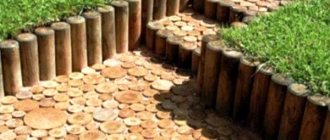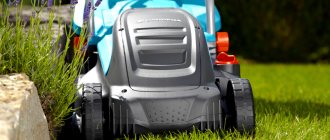A rake is a tool that is available in the shed of almost any summer resident. Despite the fact that these are quite primitive devices, in the opinion of many gardeners, they make everyday work much easier, since at the same time they can provide assistance in collecting plant debris, leveling a plot of land and caring for grass.
It doesn’t matter at all whether you are a summer resident with many years of experience or just a beginning landowner - you will definitely have a good rake among the numerous equipment in your house. Depending on the purpose of use, rakes come with different grip widths, the length of the handle itself and the shape of the existing teeth, as well as their location relative to each other.
Below we will talk in more detail about the differences between different types of rakes and try to understand what you must pay attention to when purchasing them.
How to choose a good garden rake
When choosing a rake, you should hold it in your hands. Important features are ergonomics and weight. They should be relatively light so as not to tire your hands and be easy to operate.
They should be tailored to their main task - some rakes are for the lawn, others are for leaves.
It is worth paying attention to the material and workmanship. The strength and durability of the product largely depends on this.
We offer wooden, metal, aluminum and plastic rakes for sale.
- The handle is an important element of the rake. Handles are usually of two types: metal and wood.
- This affects weight, portability, as well as length of use and price.
- The handle of the rake should be adjusted as much as possible to the height of the person using it.
Working part material
The “fan” of the rake can be made of metal or plastic. Metal fan rakes are highly durable and have a long service life. Their teeth do not break, the working part can easily withstand high loads. Temperature changes and ultraviolet radiation do not affect the strength of the metal. But plastic fan rakes also have their advantages. They may not be as strong, but they are light, flexible, inexpensive and not susceptible to corrosion. For delicate cleaning of areas with delicate vegetation, it is better to use a plastic rake with non-sharp teeth.
Types of garden rakes
The days when a gardener had no choice of tools are long gone. There are dozens of models of rakes for various purposes on the market, made from traditional and modern materials.
- Universal rakes can be divided into narrow, standard and wide. They are selected as needed for hard-to-reach corners or places with a large, flat surface. They are also often called straight rakes. They usually have 12-15 teeth set perpendicular to the beam. Made from various materials. The most popular combination is a metal working part with a wooden handle.
- Specialty rakes include a leaf rake, a grass rake, and a hay rake.
Important points
When purchasing a rake, it is important to consider the future scope of their use. You should immediately decide for what purposes and specifically where you will use this construction equipment. In order for the product to last as long as possible, it is important to consider the following points.
Firstly, if you need a rake to cultivate the land, then it is best to choose equipment with a metal base. But if you only need a tool for collecting leaves, then plastic products will do the job perfectly, since they are lightweight, have a fairly wide range of teeth and can easily grab a lot of debris at once.
Secondly, for processing bushes with berries, it is best to use a tool with a narrow base.
Thirdly, using the sliding handle, which many modern models have, you can easily adjust the size depending on the person’s height.
Fourthly, the attachment of the handle to the block should be as strong as possible.
Fifthly, the most comfortable handle width is no more than 4 mm.
Finally, sixthly, when purchasing equipment from a seller in a hardware store, there must be various certificates confirming the quality.
If you decide to make a rake yourself, then according to the instructions, it will be quite easy to follow all the steps sequentially.
However, it is worth noting that today homemade rakes are no longer the norm, but a real exotic, since the price of ready-made equipment is affordable for everyone, and you can purchase it in any store.
However, there are still situations when there is a need or a simple desire to make a rake yourself. In this case, it is enough to find on the Internet a diagram and recommendations for the type of rake you like. Make the upcoming work on the land not only productive, but also enjoyable, and the right choice of tools will provide indispensable assistance in growing a good harvest every year.
Types of combs
As for combs, they are usually divided into three types. This:
- The combs are universal. They have from 12 to 15 teeth, they are 40-50 centimeters wide. Sometimes the outer teeth have a slightly different profile than the inner teeth, so you can rake a variety of surfaces accurately. When rakes are used for raking grass and turf (in fields), you can choose those that are mounted on skids or wheels. Then the teeth are slightly raised, which means they do not cling to the ground.
- Combs for raking leaves. Their width can vary from 40 to 60 centimeters. The teeth are tightly set and the ends are sharp enough not to damage the turf. In addition, they are quite flexible. Manufacturers are currently trying to find a way to prevent rakes from becoming clogged with leaves, but it is not yet 100% effective. It all depends on the number and type of fallen leaves.
- Small combs, usually not exceeding 15-20 centimeters in width. They are often plastic, for more general use (such as raking grass clippings in the home garden). Their design often resembles a leaf rake.
Rake. All types, characteristics and recommendations for selection
For gardeners and gardeners, rakes are one of the main tools for working on the ground.
Also, the device of the same name is used in agriculture, but here we are talking about heavy tractor-mounted equipment.
There are a huge number of types of rakes, and each of them is created to perform a specific job, has a special design, and a wide range of materials are used in the production of the tool itself.
Rake: purpose
Garden rakes are used in the garden and vegetable garden; depending on the type of this tool, they can perform various tasks, from cleaning lawns from mown grass to breaking up clods of soil, thereby improving its aeration, that is, saturation with air and moisture.
The tool is also used for collecting garbage, loosening beds, raking leaves, picking out weeds and stones.
A rake is used to loosen, level the soil, and straighten the beds.
The cottage is not the only place where rakes are used. Agricultural types of this tool are mounted or trailed equipment for field work.
Depending on the design, they are used for raking and tedding hay and grass, wrapping and spreading windrows.
Design, characteristics and principle of operation
Each type of rake has a number of features.
The simplest hand tool is a transverse bar (ridge, working crossbar) with pointed teeth, mounted on a handle.
The teeth themselves are located at an obtuse, acute or right angle relative to the handle.
Rakes differ in size, weight, number of teeth and their length.
In the production of this tool, various materials are used, which are combined to lighten and at the same time increase the strength of the structure.
The rake's spine can be either straight or curved, and the handle is often called a rake.
Types of teeth
The main difference between rakes is the configuration of the teeth.
Short models with a narrow comb are designed for hard-to-reach places and can have 2-4 teeth, while standard long rakes have a minimum number of teeth of 8 pieces.
Options with closely spaced teeth are also produced, the number of which on the crossbar can reach 18 pieces, that is, twice as many as the standard options.
The shape of the teeth is:
- Straight ones are the simplest metal flat teeth located across the working bar, thereby increasing the area of their impact during operation.
Effective in raking up debris, leaves and grass. - Twisted - similar to the previous ones, but pointed towards the end, and turned 90 degrees at the base or closer to src=»https://specmoskran.ru/images/2/grabli-dlya-chego-11B90C8.jpg» class=»aligncenter» width=”640″ height=”431″[/img]Such teeth are used for loosening the soil.
- Crescent - the teeth are made in the shape of a sickle, located, like the others, perpendicular to the working crossbar, pointed, and bent towards the handle. When working, they carefully cut through the soil, ensuring its better saturation with oxygen and moisture.
- Nail - resemble the shape of nails.
All of the above teeth are flat, however, on some rakes they are pinned (perpendicular round pins, analogous to straight flat models), wire or plate.
The last two options are installed on fan models.
Material
The working part of the simplest rake is made of painted iron, and the handle is made of wood.
This design has a lot of disadvantages, including high weight and rapid wear of the teeth, but it is perhaps the cheapest option.
Direct competitors are steel models, which are also massive, but more durable.
There are also wooden rakes; despite the apparent fragility of the structure, such a tool is quite effective.
Wooden instruments are quite difficult to find on sale, because... Most often they are made by home craftsmen for their own needs or for their friends.
A carefully assembled structure made of ash and birch is a worthy replacement for metal models, for example, when harvesting hay.
The main advantage of wooden rakes is their lighter weight.
A rake is a tool, the production of which was not without attempts to lighten the design.
Models that use hardened aluminum to make both the working part and the handle weigh 800 grams, while their strength remains at a high level.
However, manufacturers did not stop there and offer customers plastic options, weighing, depending on the handle, 200 - 400 g.
It should be noted here that elastic, but at the same time durable plastic is used in manufacturing, so you don’t have to worry about the reliability of such a tool.
Dimensions and weight
The dimensions of the rake model of the same type may differ from each other.
An ordinary garden tool often reaches a length of 1400 mm, a working part width of 280 mm, and a total weight of 1.2 kg.
Moreover, as a rule, such rakes have 8 teeth. If we take into account the main range of species on the market, we can talk about the following characteristics:
- Length: 1.3 – 1.8 m.
- Working crossbar width: 28 – 46 cm.
- Handle diameter: 25 – 40 mm.
As for the size of the teeth, their height ranges from 65 to 90 mm, and the distance between them is 40 to 60 mm.
At the same time, depending on the type of tool, the rake has from 2 to 18 teeth, but there are models with a larger number.
Flower rakes differ from standard models in their compact size; they are approximately 8-15 cm in length, and the width of the crossbar with teeth is about 5 cm; their weight, as a rule, does not exceed 150 grams.
Types of rakes, their prices
Today you will learn what rakes are, how they differ and where they are used.
The classification of this tool is carried out simultaneously according to several parameters, but the first thing you should focus on is the type of tool.
So, all existing rakes are divided into:
- Garden (hand) - a tool with a handle and a crossbar with teeth.
- Agricultural (tractor) - mounted, semi-mounted or trailed models, aggregated with a tractor. Such equipment is used for the production of hay and forage grasses in large-scale livestock farming.
- Horse -drawn rakes are wheeled rakes with a frame to which a drawbar or shaft is attached and a seat for the worker is mounted. A similar design is used for raking ears of grain or hay. This device can be purchased for a walk-behind tractor, or for a horse-drawn cart.
Tractor rakes are designed for collecting grass into windrows and wrapping them.
They are also used for raking and tedding plant material in swaths.
All models according to the direction of roll formation are divided into:
Transverse
Designed for collecting mown and dried grass from the swath, forming windrows located perpendicular to the movement.
The main structural element is a rake bar on a frame, from which long curved teeth come, forming a box.
Horse rakes have approximately the same design.
Lateral
Designed for tedding dried grass in swaths, raking it into windrows formed longitudinally, that is, along the movement.
Such equipment is heavier than transverse equipment, but when harvesting high-yielding grasses they are more efficient, are able to copy the microrelief of the area, and have less material loss.
Rake handle
Aluminum handles are the most commonly used handles these days. They are lightweight, damage resistant and very durable. Sometimes they have an additional element that increases the comfort of work.
The second type of handle is wooden. It is somewhat heavier than aluminum and requires protection from moisture. However, it is cheaper in cost and is not inferior to aluminum in reliability.
A little bit of history
It is impossible to reliably say where and when this tool first appeared, but the first mentions of rakes date back to the third millennium BC. Initially, a rake was any tool that could be used to pick up and hold something. The hand was also called a rake, however, this still occurs today, but previously this term did not have an offensive meaning.
According to historians and archaeologists, there were no plates in Rus', and the family (usually a large one) ate from one common cast iron pot at the same time. First, the head of the family, often the father, took the sample, and after the first spoon he gave the command: “Rob!” and the whole family began to eat. Even now in Russia, villagers may call a fork and spoon a “rake,” which essentially means any cutlery.
The materials for making rakes are: iron, steel, aluminum, plastic, wood. An additional design feature of some rakes is cast all-metal bars with teeth, which greatly strengthens the structure.
How to care for a rake
Rakes, like other garden tools, require proper care. Many people often miss this aspect.
After work, you should clean them and wipe them dry. The rake should be stored in a warm, moisture-free room. Metal elements can be additionally protected with an anti-corrosion agent.
Wooden handles must be treated with good quality impregnation from time to time.
What are the benefits of fan rakes and how can you use them?
The thin curved teeth of a fan rake are very convenient for raking up garden waste. For delicate cleaning of a garden plot from fallen leaves and mown grass, there is perhaps no better hand tool. Fan rakes are lightweight - you can work with them for a long time without feeling tired. The teeth of the fan rake are flexible and elastic - you can not be afraid of causing damage to the soil and vegetation. And their teeth are thin and easily remove debris from hard-to-reach places, thickets of bushes, flower beds and flower beds.
Why not the cheapest rake
The most expensive rakes from well-known manufacturers are not always the best choice, but in the vast majority of cases, the worst thing you can do is choose the cheapest model.
In the case of a rake, a simple gardening tool, precision is important, something that cannot be expected from the most budget options.
- Raking, whether for grass or leaves, should not damage the turf. Therefore, it is desirable that they be relatively light, confidently maneuvered or equipped with a sled.
- It is equally important that the rake does not deform and is securely fastened - this is the biggest problem with models with variable head geometry. If the position of the rake cannot be precisely controlled, the risk of plant damage increases.
- The rake must be durable. Produced a long time ago and made from materials that are often not used today, examples were much more durable than modern versions. Perhaps the current rakes are made from better materials, but according to inferior, less ergonomic designs. Meanwhile, rakes are so trivial that if chosen correctly, they can last for many years, and you will no longer have to worry about buying another tool.
- Garden rakes should be handled with due care. It may be a simple, almost primitive tool, but it is a rake that keeps flower beds and lawns tidy, and choosing the right one cannot be based solely on price analysis.
Traditional rake
Each of us is familiar with them from an early age and are better suited than any other type to perform the following work in the garden:
- land cultivation;
- breaking clods of dirt directly on the site;
- collecting sheets and other waste;
- processing a large number of potato bushes;
- extracting, if necessary, various roots from the ground.
Traditional models can have metal plates of any shape: the most common ones are when the teeth are slightly bent in the opposite direction for better picking up a handful of earth, or they are turned exactly 180 degrees.
There are rakes that have different widths for the gripping part. For most hard-to-reach places, today you can easily pick up even a very small tool, the size of which will be from 10 to 20 cm.
If you don’t know how to choose a rake for the most efficient harvesting of grass or, for example, hay, then keep in mind that in this case the first thing you need to pay attention to is that the rake is made of wood, has short teeth and a wide base. Most often, this particular type is purchased by city authorities for cleaning various park areas.
Every year fan models are becoming more and more in demand. They are inexpensive, have a working base, and look like a broom, but are nevertheless ideal for collecting leaves and other debris.
For those people who are engaged in landscape design, which is popular today, special rakes with a large number of attachments have been produced to help in cultivating the lawn and even small bushes.
Price and quality of rakes
Unfortunately, when choosing this accessory, the financial argument often prevails. It is not necessary to immediately choose the most expensive model from a well-known manufacturer. However, in the case of rakes, the importance of quality over price is quite clear.
The rake must be strong, the teeth must not be deformed, and the head must remain in place. A rake gets used a significant amount of the year, so it's a tool that shouldn't let you down.
When choosing a rake, you should not focus only on price. A copy at a low price may well last for many years. A thoughtful choice will allow you to use this tool for many years.
Twisted tool
This type of rake is made of thick, durable material. Therefore they are quite heavy.
They are distinguished by high strength due to the twisted shape of the teeth. They very rarely break, so this is the most suitable option for heavy earthworks.
DIY tool box according to drawings: instructions with step-by-step guide- Form for paths - a large selection of forms and a simple method for creating a beautiful and comfortable garden (photo + video)
Do-it-yourself snow blower - we remove snow easily, an overview of designs and types for a suburban area











